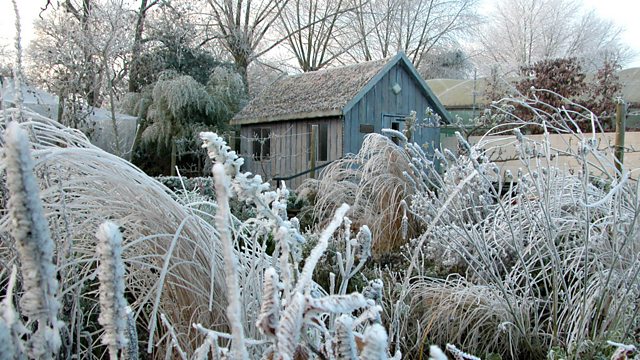Postbag Edition
Answering the listeners' correspondence for a postbag edition of the show, Pippa Greenwood, Matt Biggs and Anne Swithinbank are in the Gardeners' Question Time potting shed.
Pippa Greenwood, Matt Biggs and Anne Swithinbank are at the GQT potting shed at Sparsholt College answering listeners' correspondence sent in by post and email. The programme is chaired by Eric Robson.
Produced by Victoria Shepherd
A Somethin' Else Production for 主播大秀 Radio 4.
Overflow and notes:
Q. We move house every 5-6 years. What can I do to make an impression upon my inherited gardens?
A. Prune the existing shrubs to thin them out before adding bulbs (such as Nerines) or bedding plants (such as Petunias) to add instant colour. Agastaches, which are herbaceous perennials, would fill gaps in borders and also add colour.
Q. My father in law has dementia and no longer remembers how to tend to his garden. How can we help him to tend to it?
A. Use old photographs to remind him of the way the garden used to look. Growing herbs, such as rosemary or mint, or salad crops can spark memories. Dark corners of the garden are to be avoided, but a garden built around a figure of 8 path is a good, practical idea.
Q. My Berberis hedge has been decimated by hundreds of tiny caterpillars. How can I deal with them?
A. This is probably a relatively new pest, Berberis sawfly, the grubs of which look very like a caterpillar. Contact insecticides would work, or a biological control for sawfly.
Q. My very old Blenheim Orange apple tree was recently uprooted by a strong wind after suffering from a white furry deposit on a number of its branches. 3-4 years ago I planted a Kiftsgate Rose to grow through it. Are the two events connected? Should we plant another apple tree in its place?
A. The Kiftsgate Rose could have been contributory to the uprooting, as a large, vigorous rose would be heavy. However, the white furry deposit was probably woolly aphid. It is recommended that a replacement apple tree be grown elsewhere.
Q. I have recently moved to a riverside garden on reclaimed marshland that sinks and occasionally has standing water. Could my essential shrubs - Viburnum Carlesii, Viburnum Bodnantense 'Dawn', Elaeagnus Ebbingei - live there?
A. The shrubs mentioned are suited to a moisture-retentive but well-draining soil such as a woodland border. Higher places could be created within the garden, such as raised beds and mound planting. Moisture-loving herbaceous plants such as Skunk Cabbage or boggy Irises will do well.
Q. I have a steep, dry, embankment to plant which is full of rubble. What plants might be suitable? We are looking for something to hold the soil together.
A. Anything that will creep and root as it goes will be good in a wild bank, including Rosa Rugosa or Rosa Pimpinellifolia. Deciduous shrubs such as Weigela and Deutzia with Clematis (such as Orientalis) or Foxgloves interspersed would work quite well, as would Hypericums or Potentillas.
Q. Is there anything to the theory of lunar planting (using the rhythm of the moon to plant crops by)?
A. There are some very eminent horticulturalists and very successful gardeners who use the method. There are several theories, but most centre on the tidal flow of ground water. To plant 'earth crops' such as carrots or potatoes using Rosie Yeoman's lunar planting method, 30th March is a 'no planting day' where as 27th March and 5th April are 'good planting days'.
Q. Cuttings inserted around the edge of the pot seem to take more readily than those inserted in the middle of the pot. Why is this?
A. In clay pots more ventilation would have been coming in from the sides of the pot, reducing the chances of the cutting rotting. Plants seem to feel more inclined to root in proximity to something else.
Q. I have grown two Jolokia chilli plants from seed. They are around a metre spread at the top, and a similar height. How much foliage is it safe to remove to over-winter them indoors? Would a warm shower room with no direct sunlight be an option for over-wintering?
A. The shower room is too muggy and dark. Chillies need a lot of natural light, with compost kept on the dry side. Keeping it bright, dry and cool will encourage it to go dormant over the winter, at which point it is safe to cut it back.
Q. I live 700ft up in southeast Scotland with good soil and fresh manure. Why are my leeks not growing this year?
A. White rot can build up in soil where alliums such as leeks, onions or garlic are grown repeatedly on the same site. Harvest some of the small leeks and inspect the roots - if there is any sign of sogginess or white fungal growth, this might be the case.
Q. I would like a plant named 'Oliver' to give as a gift. Can the panel think of anything suitably-named?
A. Oliveranthus - a succulent, an Oliver blue bearded Iris, a pink Dianthus Oliver, the sky blue Delphinium 'Oliver' or Campanula 'Oliver's Choice'.
Q. Is it possible to tap maple syrup from sugar maple trees grown in England? If not, could the panel suggest anything similarly delicious?
A. It is possible to tap Birches for their sap which can be turned into Birch sap wine.
Last on
Broadcasts
- Fri 25 Jan 2013 15:00主播大秀 Radio 4
- Sun 27 Jan 2013 14:00主播大秀 Radio 4
Six of GQT鈥檚 naughtiest gardening innuendos
When Gardeners' Question Time got mucky.
Podcast
-
![]()
Gardeners' Question Time
Horticultural programme featuring a group of gardening experts


